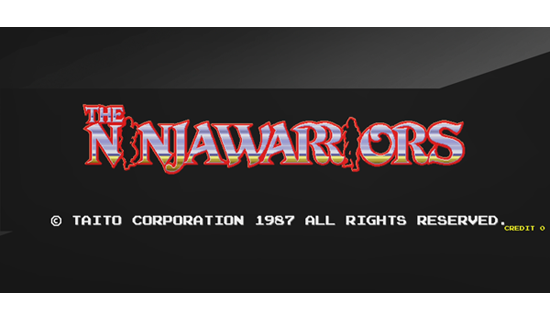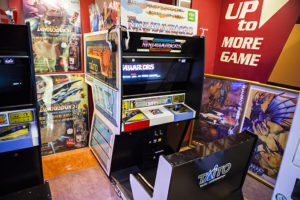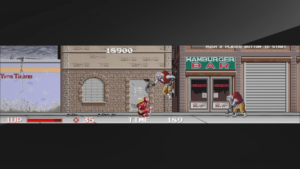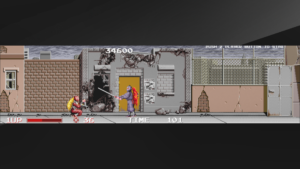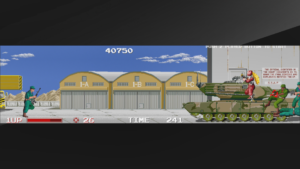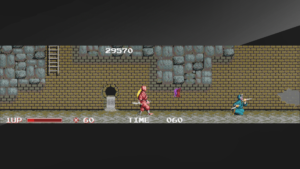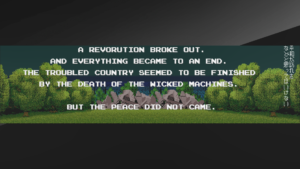Just a year prior, Nekketsu Kouha Kunio kun and Double Dragon began to change the beat-em-up landscape by taking things off of a single plane, allowing characters to move up and down on the screen. However these sorts of trends usually take time to catch on, and games take time to develop. So The Ninja Warriors follows in the footsteps of the genre’s grandfather Spartan X, and remains on “the belt”. And if not for the the previously mentioned titles, the advancements that The Ninja Warriors introduced may well have made it as significant to the genre.
This title was also significant for Taito, and for arcades in general. It was Taito’s second three-screen arcade game, following Darius (1986). Also like Darius’ cabinet (and Dariusburst Another Chronicle many years later), the deluxe version of The Ninja Warriors cabinet featured a “Body-sonic” seat with speakers underneath it that kicked out some powerful bass. This gave the sensation of being able to feel the vibrations from the music as you were playing, for a much more powerful experience. The sound chip featured in the cabinet was a Yamaha YM2610, and though this was Taito’s first cabinet to use this chip, it would become a favoriteof theirs in future cabinets.
Like most work from Taito’s in house sound team Zuntata, The Ninja Warriors is well remembered for its music. But most of all for its first and last stage theme “Daddy Mulk”. It’s basically a requirement on the set list of any of their occasional live performances. The soundtrack was primarily composed by former Zuntata member Hisayoshi Ogura (aka OGR), who was also a composer for Darius, Legend of Kage, Time Gal, Kiki Kaikai (Pocky and Rocky), Arkanoid, Scramble Formation, and other later titles. A tsugaru shamisen was sampled for the solo, and voice samples were used as well, both of which were incredibly unique for the time. You can read a great interview by the fantastic Heidi Kemps with Ogura here on gaming.moe. It specifically goes into some detail on the process of composing Daddy Mulk. There’s also a very good interview with him on game music composition in general as a part of “Beep: A Documentary History of Game Sound” which can be purchased here.
For a beat-em-up, the story of The Ninja Warriors is pretty action movie-like, in fact it could be straight out of one of the Hollywood ninja movies that were prolific in the 80s. It’s the year 1993, and the nation is in crisis. An evil dictator named Banglar has used evil magic to assume the office of the President, and society has deteriorated under the chaos and martial law that’s ensued as a result. Amidst this, a rebellion against the government has formed, led by Sir Mulk. In order to assassinate Banglar, they’ve secretly developed two ninja-inspired android killing machines named “Kunoichi” and “Ninja”. These androids have but a single mission: To assassinate Banglar and bring the dire state of things to an end.
The game features six stages, and two player simultaneous play. Player one is Kunoichi, and player two is Ninja (who has considerably more health). However use two player mode with caution: The number of enemies does actually scale up, along with boss health going up and a generally more difficult last stage. And the last stage is already difficult enough without that adding to things. This stands in direct opposition to Double Dragon, where the game is scaled for two players even if you’re playing by yourself.
Armed with a kunai for short range attacks, a limited amount of less damaging shurikens for long range attacks, and a walking speed that’s WAY too slow, you face constant barrages of soldiers that come at you at a pace that’s somewhere in between Spartan X (reasonable) and Hokuto no Ken on the Master System (maybe a little too fast). There are a lot more enemies who fire guns at you as well, instead of the occasional knife thrower in Spartan X. There you would either jump or crouch under the knife, and then you had plenty of time to close in on them for the kill. Since we’re dealing with bullets here, they’re coming a bit more rapidly, leaving you with two choices: Plan your crouches well, or use your shurikens. Remember that your shurikens are limited though, so there are a couple of new mechanics that you can take advantage of to deal with this. You can actually move forward while crouching, so your progress isn’t just brought to a halt while you wait for the bullets to clear. In fact many strategies for progressing in this game involve ducking almost the entire time (there are enemies later on that will discourage you from doing that, don’t worry). The other is holding your kunai up to block as you close the distance between you and the firing enemy. The disadvantage to that though is if you have gunman on both sides (which happens a little bit more often than I’d like), it’s no longer effective. The block is still a necessary skill to master though, since it’s imperative for beating bosses such as the spiked ball and chain guy wearing armor.
And there are plenty of challenging enemies thrown your way that aren’t even bosses. Several different types of robots (including other robot ninjas and kunoichi) will appear at various points to make your life varying degrees of miserable. The secret to these enemies tends to be crouching and blocking, baiting them to make their attacks and jump over you (which pretty much all of them do). At that point you attack them before they’ve turned around to face you again, and repeat the process. Some of the ninjas are exactly the opposite though: You want to get them crouching at you so you can jump over them and blow them up from the other side. Like most beat-em-ups, this can all be overcome by learning patterns and strategies, it’s just that the curve is significantly steeper here than we’ve seen so far from the genre. Very significantly.
And the difficulty goes nowhere but up as the levels progress. The last level is kind of a bunch of bullshit: The previous bosses repeated multiple times, amidst a maze of stairs going between floors that can lead to dead ends. Sometimes avoidance is the best strategy: You just jump over them or go up/down nearby stairs to move on. You can make an argument that it’s the last stage, but…Anyway, you end up getting to assassinate the “President” Banglar with one swipe of your kunai at the end.
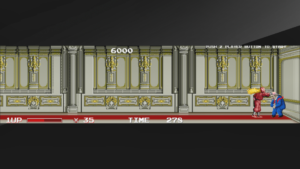
The Ninja Warriors definitely wears that it’s an arcade game that is meant to overwhelm you and take your money on its sleeve, even more than the arcade version of Spartan X did. And while it does represent a unique 80s action movie aesthetic, and is an amazing technological accomplishment in terms of both display and game music, I don’t actually find it that much fun to play as a beat-em-up. It requires more pattern and strategy study than its predecessors did, though it isn’t as ridiculous in that department as some later games would prove to be. Even so, I feel that in a world where the beat-em-up stayed on a single plane, this could easily be our Double Dragon.
Two well known console ports appeared on PC Engine (this port also appeared on the Wii Virtual Console) and Mega CD, though the Mega CD version is much more highly regarded due to it being much closer to the arcade version and featuring an alternate arrange soundtrack. The west also received a handful of computer ports on the Amiga, Amstrad, Atari ST, Commodore 64, and ZX Spectrum. There were about four different mobile phone ports for various platforms in 2006, though they never left Japan. By the far the best way to play this outside of an actual arcade cabinet though, is Hamster’s 2017 Playstation 4 port as a part of their Arcade Archives series. It features a mode that emulates the original three screen cabinet, as well as the Japanese, North American, and European ROMs.
